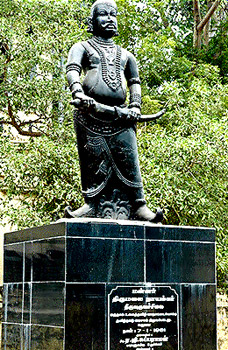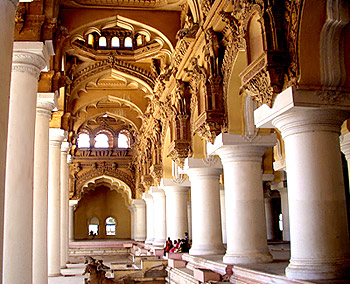Nayaka dynasty of Madurai consisted of thirteen rulers. Among them nine of them were kings, two were queens and two were kings jointly. They belonged to Telugu speaking Balija social group. The most notable of these were the king, Tirumalai Nayaka and the queen, Rani Mangammal.
After Vishwanatha Nayaka took over it was held by the Nayak dynasty for two centuries, until Muslims took it in 1736 for a brief period before the British took it during the 1780s.
In 1538 AD, the commander of Vijayanagara Empire Kotikam Nagama Nayaka defeated Veerasekara Chola who occupied the Pandyan region. However he declared independence from the Vijayanagar dynasty. In order to check the rebellion of Nagama Nayaka, Emperor Krishnadeva Raya of Tuluva dynasty sent a large force under Viswanatha Nayak. Vishwanatha Nayaka was the son of Nagama Nayaka who eventually defeated and imprisoned his father.
Viswanatha Nayaka
Viswanatha Nayaka was the viceroy of Vijayanagara to Madurai in South India during the 16th century. He was crowned as the Madura king by Achyutadeva Maharaya. He strengthened his capital and improved the administration of his dominions who was supported by his able general Ariyanatha Mudaliar. He ruled from 900 to 950 AD, and was succeeded by Varadappa Nayaka.
Kumara Krishnappa (1563-1573)
Viswantha Nayak was succeeded by his son Krishnappa Nayak. He expanded the Madurai Kingdom under the Nayaks and brought most of the ancient Pandyan territory under its rule. Kumara Krishnappa was a brave and politic ruler.
Joint rulers
Kumara Krishnappa was succeeded in 1573 by his two sons Muttu krishnappa and muttu Veerapa, who ruled jointly and uneventfully until 1595.
Muttu Krishnappa (1602-1609)
He had given the Setupatis of Ramnad in the Maravar region, on condition that they suppress crime and protect pilgrims journeying to Rameshwaram.
Muttu Virappa (1609-1623)
He was succeeded by his eldest son, Muttu Virappa. He constructed the fort of Dindigul at Dindigul on the Hill, along with the Temple on it, which later was completed by Tirumalai Nayak. However it is considered that his rule was not praiseworthy.
Tirumalai Nayak
 Muthu Virappa was succeeded by the great Tirumalai Nayak, the most powerful member of his dynasty, who ruled for thirty-six years. Before him taking over, the court of Madurai was being held at Trichy for some ten to twelve years. He made Madurai his capital. He was assisted by his Dalavay Ramappayan. He died in 1659 in his capital Madurai.
Muthu Virappa was succeeded by the great Tirumalai Nayak, the most powerful member of his dynasty, who ruled for thirty-six years. Before him taking over, the court of Madurai was being held at Trichy for some ten to twelve years. He made Madurai his capital. He was assisted by his Dalavay Ramappayan. He died in 1659 in his capital Madurai.
Muttu Alakadri (1659-1662)
Tirumalai Nayak was succeeded by his son Muttu Alakadri. He tried to persuade the Nayak of Tanjore to join the enterprise. The Muslim invaders moved against Trichinopoly and Madurai thereby spreading chaos. However due to several difficulties faced by the locals they had to withdraw. However Muttu Alakadri gave himself to dissipation.
Chokkanatha Nayaka (1662-1682)
Chokkanatha Nayaka succeeded Muthu Alakadri Nayak.
Rangakrishna Muthu Virappa (1682-1689)
Chokkanatha Nayaka was succeeded by Rangakrishna Muthu Virappa who was a spirited boy of fifteen. He tried to revive the fortunes of the kingdom. He possessed a sound sense and ability which evoked the admiration of his ministers. Eventually he recovered his capital in 1685 and he gradually recaptured large parts of the ancient kingdom of his forefathers thereby restoring the powers of the Nayaks of Madurai. He died at an early age of 22.
Rani Mangammal (1689-1704)
Rani Mangammal, the mother of the late Nayak was the Queen-Regent on behalf of her grandson. She was the most popular among all her rulers. She was a skilled administrator and is remembered as a maker of roads and avenues, and a builder of temples, tanks. She is known for her diplomatic and political skills and successful military campaigns.
Vijaya Ranga Chokkanatha (1704-1731)
She was succeeded by her grandson Vijaya Ranga Chokkanatha, He ruled for 26 dull years thereby leading to the decline of the dynasty. He was weak-minded. He was generous with the Brahmins and distributed gifts to them and religious institutions.
Rani Meenakshi
Vijaya Ranga Chokkanatha died in 1731. He was succeeded by his widow Meenakshi, who acted as Queen-Regent on behalf of a young boy she had adopted as the heir of her dead husband. She ruled probably for a year as a revolt was raised by Vangaru Tirumala, the father of her adopted son, who claimed the throne of Madurai. The Mughals played a major role at this juncture.
Decline of Nayaka dynasty of Madurai
 In 1734 Meenakshi and Vangaru Thirumala were fighting for the crown. An expedition was sent by Nawab of Arcot in order to exact tribute and compliance from the kingdoms of the south. The invaders took Tanjore and left Trichinopoly untouched. While returning from their voyage they took part in the quarrel between Meenakshi and Vangaru Tirumala. Vangaru Tirumala approached Safdar Ali Khan with an offer of three million rupees if he would oust the queen. He declared Vangaru Thirumala to be king and took the bond for the three millions.
In 1734 Meenakshi and Vangaru Thirumala were fighting for the crown. An expedition was sent by Nawab of Arcot in order to exact tribute and compliance from the kingdoms of the south. The invaders took Tanjore and left Trichinopoly untouched. While returning from their voyage they took part in the quarrel between Meenakshi and Vangaru Tirumala. Vangaru Tirumala approached Safdar Ali Khan with an offer of three million rupees if he would oust the queen. He declared Vangaru Thirumala to be king and took the bond for the three millions.
Queen Meenakshi made him swear on the Koran that he would adhere to his engagement. He was admitted into the Trichinopoly fort and Vangaru went off to Madurai to rule.
Chanda Sahib accepted the crore of rupees and headed off to Arcot. In 1736 he returned and was admitted into the fort and acted as master of the kingdom. Meenakshi fell in love with Chanda Sahib and so never interrupted him. He defeated Vangaru Thirumala at Ammaya Nayakkanur and Dindigul and forced him to take shelter in Sivaganga and occupied the southern provinces of the Madurai kingdom. Now he was the master of Meenakshi`s kingdom he threw off the mask and locked her up in her palace and was declared as the ruler of her kingdom. She ended her life by consuming poison.






































